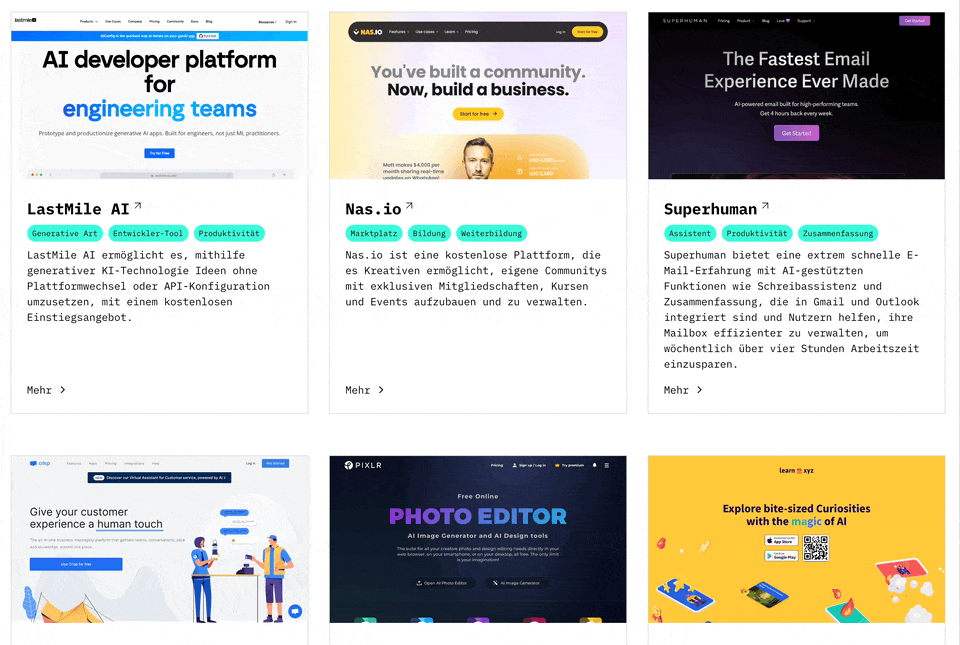Navigating the AI Gold Rush: Finding Unique Opportunities in a Soon-To-Be Saturated Market

Recently, I was thinking about launching a product MVP using generative AI, just to test the market, my skills, and probably build something great. And I assume you have thought about this as well. Just take a use case that’s currently being solved in a “traditional” way, and apply AI to it—done. And with AI in its value proposition, it will market itself, won’t it? Yeah, that would be too easy. I typed a bunch of my ideas into Google and Perplexity to see if there was anything already out there—and tens of ideas ideas later, with AI startups already built around them, I had the feeling that I wouldn’t be able to keep up with the race.
The race to create AI-based products has become a competitive marathon, with countless organizations vying to bring their solutions to market. The challenge of finding a truly unique AI use case is daunting. I just discovered this huge curated list at Advanced Innovation—and not to forget about ProductHunt—which showcases thousands of AI products emerging daily. It made it clear to me how saturated the market will eventually become with AI solutions. This landscape illustrates a critical reality for aspiring AI entrepreneurs and product managers: standing out in this crowded field requires more than just a good idea.

Thousands of AI tools, with new ones released daily. How can you find your sweet spot here?
The Challenge of AI Product Ideation
Many fall into the trap of picking an use case and hastily wrapping an AI product around it. While leveraging inflection points—like the rise of Generative AI—can seem like a promising strategy, this approach alone often lacks the necessary depth to succeed. It prioritizes rapid revenue generation without addressing genuine business needs, resulting in products that fail to resonate with the market long-term.
And let’s face it—while there’s an AI product for every use case, even for personal, creative use, you have to become a seasoned CIO to manage hundreds of subscriptions to all these apps, platforms, and browser extensions.
Inflections, Insights, and Founder-Future Fit
I just listened to the recent episode of Lenny’s Podcast, where Mike Maples reveals in-depth insights into what makes a startup idea successful. in his conversation with Lenny, Maples outlines three crucial elements for identifying a successful startup idea: Inflections, Insights, and Founder-Future Fit.
Inflections: These are significant shifts that create new opportunities. For example, the advent of Generative AI represents a major inflection point, opening new avenues for innovation. However, merely capitalizing on these shifts without deeper insights often leads to superficial solutions.
Insights: A deep understanding and unique perspective on a problem are invaluable. Insights go beyond the obvious, uncovering underlying needs and pain points that others might miss. This level of understanding is critical for creating products that offer real value.
Founder-Future Fit: This element emphasizes the alignment of the founder’s vision and capabilities with the future of the industry. Successful founders possess a unique ability to foresee industry trends and position their products accordingly.
Real Business Needs First
I am talking mostly about B2B here, but I believe the case is similar for consumer products: focusing on real business needs before applying AI technology is a more effective strategy. It could be even the case that the business problem does not require or benefit from AI to be solved. Through personal experience, I have learned that identifying genuine problems and addressing them with AI second leads to more sustainable and impactful solutions. For instance, consider a company struggling with customer support efficiency. Instead of developing a generic AI customer service agent, understanding the specific challenges and integrating AI to enhance existing workflows would result in a more effective solution, since these workflows will vary from one organization to the next. I recommend this post from Jaser Bratzadeh, where Jaser explains his framework for decision making when and when not to use AI, and to which extend, based on the underlying business process.
The Wave of New Ideas and Subsequent Consolidation
Inflections like Generative AI often spur a wave of new ideas, products, and tools designed to solve very specific use cases. During the initial hype, the market sees an explosion of startups and innovative solutions. However, as the hype settles, consolidation typically follows, resulting in fewer, but stronger and more generic vendors.
For instance, in the AI domain, the rise of chatbots in the mid-2010s led to a plethora of startups each offering chatbot solutions for customer service, marketing, and more. According to CB Insights, the peak of the chatbot hype was in October 2016, with a significant number of VC-backed chatbot startups that no longer exist today. Fast forward a few years, and we see significant consolidation, with major platforms like Microsoft and Salesforce incorporating advanced AI-driven chatbots into their broader suite of services. And today, they rised again—but they are called “AI agents” now, which is likely the case to navigate around the negative experiences that customers associate with them, in times where they had been far from being intelligent.
The Future of GenAI and Commoditization
As Generative AI, particularly large language models (LLMs), becomes more commoditized, we can expect many AI products solving very specific use cases to either consolidate or be acquired by larger vendors. Mike Maples’ findings indicate that a large number of successful startups pivoted from their original ideas. The need for flexibility and adaptability becomes an even more critical success factor in the rapidly evolving AI landscape.
For example, Instagram actually started as a location-based check-in app called Burbn before pivoting to photo-sharing, demonstrating how startups must be willing to evolve. Similarly, many AI startups might need to shift their focus as the market and technology landscape change.
Conclusion
In conclusion, understanding and adapting to the dynamic nature of the AI industry is crucial for success. Mike Maples’ book, Pattern Breakers: Why Some Start-Ups Change the Future, co-authored with Peter Ziebelman, delves deeper into the concepts of what makes startups successful—and I strongly believes it matters even more in the age of Generative AI. Entrepreneurs must take these insights seriously to navigate this new age of AI successfully.
The AI gold rush is well underway, and while the market may eventually become saturated, opportunities still abound for those who can uncover really genuine needs and address them with innovative solutions. By focusing on real business needs, leveraging deep insights, and maintaining flexibility, aspiring AI product managers can find their unique path to success in this competitive landscape.

